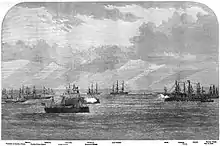HMS Invincible (1869)
HMS Invincible was a Royal Navy Audacious-class ironclad battleship. She was built at the Napier shipyard and completed in 1870. Completed just 10 years after HMS Warrior, she still carried sails as well as a steam engine.
.jpg.webp) HMS Invincible off Plymouth, 1870 | |
| History | |
|---|---|
| Name: | Invincible |
| Builder: | Robert Napier and Sons |
| Laid down: | 28 June 1867 |
| Launched: | 29 May 1869 |
| Commissioned: | 1 October 1870 |
| Renamed: | HMS Erebus, 1904; Fisgard II, 1906 |
| Reclassified: |
|
| Fate: | Sank, 17 September 1914 |
| General characteristics | |
| Class and type: | Audacious-class ironclad battleship |
| Displacement: | 6,106 long tons (6,204 t) |
| Length: | 280 ft (85 m) |
| Beam: | 54 ft (16 m) |
| Draught: | 22 ft 7 in (6.88 m) |
| Installed power: | |
| Propulsion: | 1 × coal-fired reciprocating steam engine |
| Speed: |
Steam: 13.5 knots (25.0 km/h; 15.5 mph) Sail: 10 knots (19 km/h; 12 mph) |
| Complement: | 450 |
| Armament: |
|
| Armour: |
|
Armament
The Audacious class was armed with ten 9 in (230 mm) muzzle-loading guns, supported by four 6 in (0.15 m) muzzle loaders. These were located in a broadside pattern over a 59 ft (18 m) two-deck battery amidships—this was the area of the ship least affected by its motion, and made for a very stable gun platform.
Early career

For the first year of her career, she was a guardship at Hull, before being replaced by her sister HMS Audacious. She was then transferred to the Mediterranean, where she served until 1886. She was sent to Cadiz in 1873 to prevent ships seized by republicans during the civil war in Spain from leaving harbour. She rejoined the Mediterranean Fleet in 1878 under the command of Captain Lindsay Brine, but her poor state of seamanship attracted the ire of the commander-in-chief, Geoffrey Hornby. In early 1879 Invincible blundered badly, putting two ships at hazard, and Brine was court-martialled. Though acquitted, Brine was relieved by Captain Edmund Fremantle.[1] She was Admiral Seymour's temporary flagship at the 1882 bombardment of Alexandria because his normal one, HMS Alexandra, drew too much to enter the inner harbour.[2] She provided men for the naval brigade that was subsequently landed and she also provided men for Charles Beresford's naval brigade in the Sudan campaign of 1885.
Later career and shipwreck
She made a trip to China in 1886 to carry out a new crew for Audacious before becoming the guardship at Southampton until 1893. Her engines were removed in 1901 when she became a depot ship at Sheerness for a destroyer flotilla. She was renamed HMS Erebus in 1904, a name that she bore until 1906, when she was converted into a training ship at Portsmouth for engineering artificers and was renamed Fisgard II (Audacious had been renamed Fisgard in 1904).
On 17 September 1914, she sank during a storm off Portland Bill with the loss of 21 of her crew of 64. She was being towed from Portsmouth to Scapa Flow where she was to act as a receiving ship for seamen newly mobilised for World War I. She now lies upside down with the bottom of the hull about 164 ft (50 m) below sea level.
HMS Fisgard II is a Designated vessel under schedule 1 of The Protection of Military Remains Act 1986 (Designation of Vessels and Controlled Sites) Order 2012.[3]
Notes
- Andrew Lambert, Admirals (London, Faber & Faber 2008), pp. 276-277
- Goodrich, Caspar F (Lt Cdr), Report of the British Naval and Military Operations In Egypt 1882, Navy Department, Washington, 1885, p.28
- http://www.legislation.gov.uk/uksi/2012/1110/schedule/1/made
Publications
- Colledge, J. J.; Warlow, Ben (2006) [1969]. Ships of the Royal Navy: The Complete Record of all Fighting Ships of the Royal Navy (Rev. ed.). London: Chatham Publishing. ISBN 978-1-86176-281-8.
- Roger Chesneau and Eugene M. Kolesnik, ed., Conway's All the World's Fighting Ships, 1860–1905, (Conway Maritime Press, London, 1979), ISBN 0-85177-133-5
| Wikimedia Commons has media related to HMS Invincible (ship, 1870). |